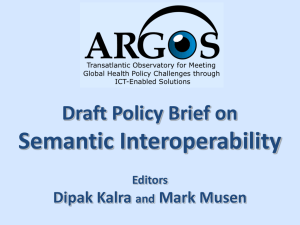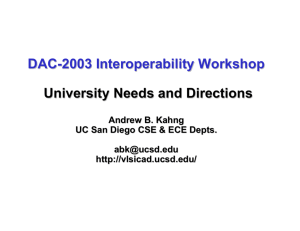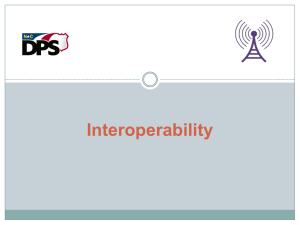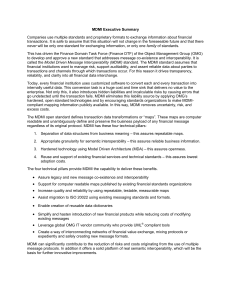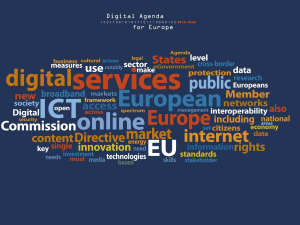Towards Enterprise Interoperability Service Utilities Enterprise
advertisement
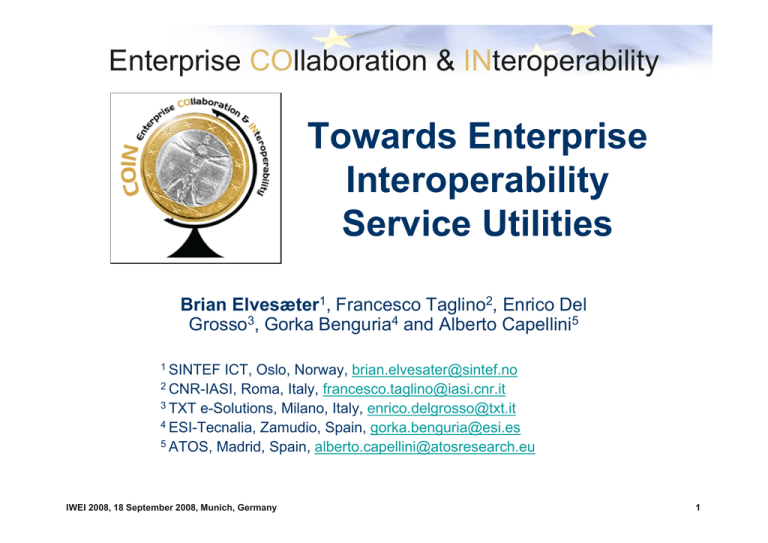
Enterprise COllaboration & INteroperability Towards Enterprise Interoperability Service Utilities Brian Elvesæter1, Francesco Taglino2, Enrico Del Grosso3, Gorka Benguria4 and Alberto Capellini5 1 SINTEF ICT, Oslo, Norway, brian.elvesater@sintef.no 2 CNR-IASI, Roma, Italy, francesco.taglino@iasi.cnr.it 3 TXT e-Solutions, Milano, Italy, enrico.delgrosso@txt.it 4 ESI-Tecnalia, Zamudio, Spain, gorka.benguria@esi.es 5 ATOS, Madrid, Spain, alberto.capellini@atosresearch.eu IWEI 2008, 18 September 2008, Munich, Germany ICT 1 Outline of presentation • • • • • • • • • • COIN in one slide Enterprise interoperability challenges and ISU Software-as-a-Service Utility (SaaS-U) Enterprise interoperability baseline (Related work) COIN EI services framework Summary of state-of-the-art analysis Proposed COIN baseline EI services Conclusion and future work Position statement Questions (and answers) IWEI 2008, 18 September 2008, Munich, Germany ICT 2 COIN in one slide COIN MOTTO: “Enterprise Interoperability and Enterprise Collaboration are the two sides of the same COIN” • The SIDE A of the COIN: Enterprise Collaboration • The SIDE B of the COIN: Enterprise Interoperability • The Substrate of the COIN: Service Platform • The Value of the COIN: Software as a Service Utility SaaS-U • The Market of the COIN: Manufacturing Enterprises (mainly SMEs) IWEI 2008, 18 September 2008, Munich, Germany ICT 3 Enterprise interoperability challenges • Enterprise Interoperability [1] is a relatively recent term that describes a field of activity with the aim to improve the manner in which enterprises, by means of information and communications technology (ICT), interoperate with other enterprises, organisations, or with other business units of the same enterprise, in order to conduct their business. • • • • Interoperability Service Utility (ISU) which envisions interoperability support as utility-like capabilities that needs to be supported by an enabling system of services for delivering basic interoperability to enterprises, independent of particular IT deployment. The term ISU is used to denote this overall system. The ISU is envisaged to provide interoperability as a technical, commoditised functionality, delivered as services. Web technologies for Enterprise Interoperability Knowledge-oriented collaboration Science base for Enterprise Interoperability IWEI 2008, 18 September 2008, Munich, Germany ICT 4 Software-as-a-Service Utility (SaaS-U) • • • • • • The ISU challenge is addressed by COIN by providing a service infrastructure for Enterprise Interoperability in the business context of Enterprise Collaboration. New business concept – the Software-as-a-Service Utility (SaaS-U) model. The SaaS-U paradigm fits well fit the ISU concepts and can be seen as a software application delivery model where a software vendor develops Web-native software services and hosts and operates them for use by its customers over the Internet. Customers do not pay for owning the software itself any longer but rather for using it on-demand. They use it through an API accessible over the Web and often written using Web services. The baseline EI services will be offered as Semantic Web Services on top of the WSMX environment [17]. IWEI 2008, 18 September 2008, Munich, Germany ICT 5 Enterprise interoperability (EI) baseline • • The COIN project aims to provide open source implementations of all its services so the focus of the analysis has been on open source software solutions. A first preliminary study of the enterprise interoperability (EI) baseline led us to identify 3 categories of results with candidates to be part of the EI services baseline. SP5 COIN Enterprise Interoperability Baseline Services Item/result Models, Standards: MDI, UPMS, POP*, EIMM, EIDM, IIAM, BIF, AIF, EI Roadmap, ISU Grand Challenge, IdaBC EIF, SOKU Knowledge Interop.: ATHOS, ASTAR, ARGOS, ARES, MOMO, Domain Ontologies, UBLbased EIB, Semantic Reconciliation Rules Business Interop.: BPMN, BPEL, iBPM, BPEL4PEOPLE, CoCoS, PIM4SOA, Process-Workflow Mining IWEI 2008, 18 September 2008, Munich, Germany Type of result Source Access Framework+models (SINTEF, IC Focus, ESI) ATHENA, INTEROP, SECSE, Modelware DGINFSO, OMG Free and Open-to-all Access OSS (Eclipse Public License) Framework+software (CNR, TXT, ESI, SINTEF) ATHENA. INTEROP, Abilities, OASIS OSS GPL License (sourceforge) Source Code Access (COIN partners) Free and Open-to-all Access Framework+software (TXT+UIBK+TUV) OMG, ECOLEAD InContext Ecospace SFIDAPMI Source Code Access (COIN partners) Free and Open-to-all Access ICT 6 Interoperability & EA frameworks Interoperability barriers Interoperability approaches Integrated Unified Organisational interoperability Federated Enterprise levels Business Semantic interoperability Process Service Technical interoperability Data Organisational Conceptual Technological EIF 1.0 INTEROP Required (Business) Processes Services Information/Data Model-Driven Interoperability Enterprise Collaborative Enterprise Modelling Cross-Organisational Business Processes Flexible Execution and Composition of Services Information/Data Interoperability Semantic Mediation Interoperability Provided EIF 2.0 (draft) Enterprise (Business) Processes Services Information/Data ATHENA IWEI 2008, 18 September 2008, Munich, Germany ARIS ZACHMAN ICT 7 Refining the EI baseline according to the AIF • The three EI baseline categories (1) models/standards, (2) knowledge and (3) business interoperability were refined into 6 EI service categories (1) model-driven, (2) enterprise modelling, (3) business process, (4) service*, (5) information/data and (6) semantic mediation according to the ATHENA Interoperability Framework (AIF) which was chosen as the baseline for the COIN EI Services Framework. Required (Business) Processes *Service interoperability is addressed by the COIN Service Platform (SP3) Services Information/Data IWEI 2008, 18 September 2008, Munich, Germany Model-Driven Interoperability Enterprise Collaborative Enterprise Modelling Cross-Organisational Business Processes Flexible Execution and Composition of Services Information/Data Interoperability Semantic Mediation Interoperability Provided ICT Enterprise (Business) Processes Services Information/Data 8 Five service categories for EI • • • • • Model-driven interoperability services support enterprises to formalise, exchange and align models that are relevant to set up collaborations. Enterprise modelling interoperability services support enterprises to factually co-operate with other, external organisations in spite of e.g., different working practices, legislations, cultures and commercial approaches. Business process interoperability services support enterprises to make proper external views of enterprise internal processes synchronised by a collaborative inter-enterprise business process. Semantic mediation interoperability services support enterprises to apply ontology-based techniques for semantic mediation such as semantic reconciliation of business documents in order to support interoperability among heterogeneous software applications. Data interoperability services support enterprises to exchange and share business documents among organizations, by filling interoperability gaps related to the payload (format and content) and to the messages and/or structures to be exchanged. IWEI 2008, 18 September 2008, Munich, Germany ICT 9 State-of-the-art analysis of existing EI tools/services (from FP6 projects) EI framework category Sub-service category Tools/services analysed Model-driven interoperability services Metamodelling Eclipse Modeling Framework (EMF) Language engineering Eclipse Graphical Editing Framework (GEF), Eclipse Graphical Modeling Framework (GMF), UML profiles Model mapping and transformation MODELWARE Model Transformation Tool Suite (MTTS), ATL model-to-model transformation tool suite, MOFScript model-to-text transformation tool suite Method engineering Eclipse Process Framework (EPF) Enterprise modelling UEML, EMPOSME, POP*, POP* profile, Reference Model for Collaborative Networks, SOA Tools Project (STP) Enterprise models interchange UEML, POP*, METIS POP*, ARIS POP*, GRAI Tools POP*, Mo2Go POP* Enterprise model deployment POP*, PIM4SOA, POP* ► PIM4SOA, PIM4SOA ► WSA, POP* ► Maestro, POP* ► JPDL Enterprise interoperability maturity assessment Enterprise Interoperability Maturity Model (EIMM) Cross-organizational business process modelling Maestro modelling tool Semantic business process modelling SUPER semantic business process modelling tool Business processes management SUPER Management Tool Business process monitoring SUPER Monitoring Tool Business process analysis SUPER analysis Ontology editing ATHOS, KAON, OILEd, OntoEdit, Protégé Ontology engineering and maintenance ODE/WebODE, On-To-Knowledge, UPON Semantic annotation ASTAR, MWSAF, WSMO Studio, Cohse, MnM, OntoMat-Annotizer Semantic transformation rules building ARGOS, OWLmt, WSMT, Semantic Bridging module Semantic reconciliation engine ARES, MAFRA Execution Engine, OWLmt Engine, WSMW Run-time Data Mediator Data mapping GIMMI Mapping Wizard, PROBO Legacy Integration Module, Semaphore Data infrastructure framework Apache Tuscany, Service Data Object (SDO), Data Access Service (DAS) Business document modelling ABILITIES UBL business document modelling Business document interchange ABILITIES Service Bus Business document process integration ABILITIES Interconnection of Business Processes Enterprise modelling interoperability services Business process interoperability services Semantic mediation interoperability services Data interoperability services IWEI 2008, 18 September 2008, Munich, Germany ICT 10 Lessons learnt • • • • The research projects on interoperability in the European Commission Sixth Framework Programme have developed a vast set of standalone software products and tools, as well as some Webbased services to address interoperability issues. However, some of these solutions are difficult to integrate and use for SMEs. Experiences from piloting activities in the ATHENA project suggested that Enterprise Interoperability is very challenging and that the expected gains from interoperability research will consist in finding technologies and methods that will fasten interconnection of applications through standardised Web infrastructure for software application communication and for collaboration [21]. In the COIN context, Enterprise Interoperability services provide functionality for applying IT solutions that overcome interoperability gaps between two or more enterprises and thus enabling them to set-up and run collaborations. The main goal of the EI services is to improve interoperability, mainly for SMEs, which means to reduce the costs of data reconciliation, systems integration and business processes synchronization and harmonization. IWEI 2008, 18 September 2008, Munich, Germany ICT 11 Proposed COIN baseline EI services EI services framework category Sub-service category Services to be implemented for M12 Model-driven interoperability services Metamodelling - Language engineering - Model mapping and transformation COIN Model Transformation Service Engine Method engineering - Enterprise modelling - Enterprise models interchange COIN POP* Transformation Service Enterprise modelling interoperability services Enterprise model deployment Business process interoperability services Semantic mediation interoperability services Data interoperability services Enterprise interoperability maturity assessment COIN Enterprise Interoperability Maturity Assessment Service Cross-organizational business process modelling - Semantic business process modelling COIN Semantic Business Process Modelling Service Business processes management COIN Semantic Business Process Management Service Business process monitoring - Business process analysis - Ontology editing Athos Ontology Service Ontology engineering and maintenance - Semantic annotation Astar Semantic Annotation Service Semantic transformation rules building Argos Semantic Transformation Rules Service Semantic reconciliation engine Ares Semantic Reconciliation Service Data mapping COIN Massive Data Interoperability Service Data infrastructure framework - Business document modelling - Business document interchange COIN Transactional Data Interoperability Service Business document process integration - IWEI 2008, 18 September 2008, Munich, Germany ICT 12 Specification of baseline EI services • COIN Deliverable D5.1.1 ”State-of-the-Art and Baseline EI Services Specifications” (July 2008, to be released at http://www.coin-ip.eu) IWEI 2008, 18 September 2008, Munich, Germany ICT 13 Benefits of COIN baseline EI services # COIN baseline EI service Provider Benefits for users 1 COIN Model Transformation Service Engine SINTEF The model transformation service engine will be a service entry point for storing model transformations that are aimed at aligning the huge diversity of models used in the design, integration and implementation tasks of enterprise applications and systems. 2 COIN POP* Transformation Service ESI POP* Transformation service will be exposed a semantic Web service in the COIN platform. This service will provide the functionality of modelling in the context of POP* to JPDL transformation. The results of the transformation should be published into the open source JBPMN platform. 3 COIN Enterprise Interoperability Maturity Assessment Service ESI The EIMA will help to assess an organization's maturity level concerning the use of enterprise models as well as the capability of these models to enable the company to be part of collaboration. Based on this assessment, companies will be guided to choose the right concepts for improving their capabilities, by taking into account actual market and enterprise challenges. Following a lightweight scope, the performance of this assessment will be done through an informal evaluation based on a questionnaire and involving few resources of the organization. 4 COIN Semantic Business Process Modelling Service ATOS The Semantic BP service will help to reduce the complexity of tasks related to transformation between different BP models as well as transformation in executable process models with semantic annotations. 5 COIN Semantic Business Process Management Service ATOS The BP Management service will to manage the life cycle of deployed BP models independently on the underlying engines actually executing the model. 6 Athos Ontology Service CNR The AthosOntologyService will provide functionalities for ontology management. Ontology is a pre-requisite for semantics-based mediation and reconciliation of business documents. 7 Astar Semantic Annotation Service CNR The AstarSemanticAnnotationService will provide functionalities for management of semantic annotations. Semantic annotation allows digital resources to be described in terms of a common reference represented by a domain ontology. Such an activity represents a first identification of semantic and structural mismatches among different information structures (e.g., business document schemas), which is needed for fulfilling interoperability issues among heterogeneous information systems. 8 Argos Semantic Transformation Rules Service CNR The ArgosSemanticTransformationRulesService will provide functionalities for management of transformation rules service. Transformation rules represent the semantic mapping able to drive the mediation and reconciliation. 9 Ares Semantic Reconciliation Service CNR The AresSemanticReconciliationService will represents the final step towards the actual mediation and reconciliation of business documents among heterogeneous information systems. 10 COIN Massive Data Interoperability Service TXT The massive data interoperability is a service to allow communication among a set of multiple data providers and a set of multiple data consumers. In a multi-point communication, the interoperability problem grows exponentially according to the number of entities involved in the communication. The service will allow the data providers to “map” their data structure to the requested schema and “fill” the schema itself with the data coming from their data sources. 11 COIN Transactional Data Interoperability Service TXT The transactional data interoperability is a service that allows the communication between two actors: a customer and a supplier. The scenario of the communication is the exchange of business documents in the order to invoice procurement process. IWEI 2008, 18 September 2008, Munich, Germany ICT 14 Conclusions and future work • • Position the COIN service platform as a technology enabler for developing and offering Enterprise Interoperability services according to the Software-as-a-Service Utility (SaaS-U) paradigm. Candidates for the development of baseline EI services based on state-of-the-art analysis of previous FP6 research projects. The development of these services will follow two phases. • The first phase involves wrapping and potentially re-implementing parts of the solutions as Web services. (Ongoing) • The second phase involves enriching the service descriptions with semantics in order to make them Semantic Web Services. (End of 2008) • Future work focused on developing new and innovative EI services for • (1) information interoperability – new service communication and coordination in business collaborations. • (2) knowledge interoperability – develop semantic profiles and the environment to expose, compare and semantically mediate such profiles. • (3) business interoperability – provide new formalisms and languages for interactive and collaborative BPM. IWEI 2008, 18 September 2008, Munich, Germany ICT 15 Position statement: Application architectures vs. “userinvolving” modelling and execution architectures #n applications a b r EAI s Integrated workplace y1 y2 Layered and hardwired application architecture with prescribed solutions coded by different programmers. • The enterprise application integrator “fixes” the interoperability issues. IWEI 2008, 18 September 2008, Munich, Germany Interactive modelling and execution platform with “user-involving” modelling and execution services. • The user “designs” the interoperation. ICT 16 References • [1] M.-S. Li, R. Cabral, G. Doumeingts, and K. Popplewell, "Enterprise Interoperability Research Roadmap, Final Version, Version 4.0", July 2006. • [17] WSMX, "WSMX (Web Service Modelling eXecution environment)". http://www.wsmx.org:8080/wsmxsite/ • [21] ATHENA A4, "D.A4.2: Specification of Interoperability Framework and Profiles, Guidelines and Best Practices", ATHENA IP, Deliverable D.A4.2, 2007. http://interopvlab.eu/ei_public_deliverables/athena-deliverables/ IWEI 2008, 18 September 2008, Munich, Germany ICT 17 Thanks for your attention! IWEI 2008, 18 September 2008, Munich, Germany ICT 18 Questions? IWEI 2008, 18 September 2008, Munich, Germany ICT 19

